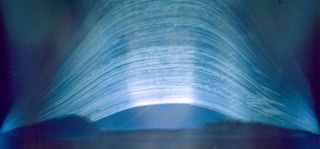Longest-exposure photo ever was just discovered. It was made through a beer can.

Eight years and one month ago, a Master of Fine Art student at the University of Hertfordshire fitted a beer can with photographic paper and created a low-tech pinhole camera. She then placed the can on a telescope at the university's Bayfordbury Observatory and eventually forgot about the project.
Now, the resulting photograph has been rediscovered — and it may be the longest-exposure photo ever taken.
"I had tried this technique a couple of times at the Observatory before, but the photographs were often ruined by moisture and the photographic paper curled up," photographer Regina Valkenborgh, now a photography technician at Barnet and Southgate College, said in a statement. "I hadn't intended to capture an exposure for this length of time and to my surprise, it had survived."
Related: Spaced out! 101 astronomy images that will blow your mind
The photograph shows the sun's journey through the sky since 2012; 2,953 arcs of light tracing its path as the sun rose and set. Part of the telescope's dome is also visible at the left of the photograph. On the right is a gantry structure designed to straddle the observatory, which was built halfway through the exposure.
Prior to this photo, the longest-exposure picture was thought to be four years, eight months, taken by German artist Michael Wesely, according to the university. Wesely takes long-exposure photographs of various scenes, such as the renovation of the Museum of Modern Art (MOMA) in New York City.
Long-exposure photography requires very small apertures, or openings in the camera lens, in order not to flood the photographic paper with light. The beer-can camera is a type of pinhole camera, a very simple device without any lens at all. Light enters through the only opening in the camera — the pinprick-sized hole — and falls on photosensitive paper inside. This creates an inverted image of whatever the camera "sees." Because of the long exposure time, only slow-moving or permanent objects appear in the resulting image; fast-moving objects are lost.
Sign up for the Live Science daily newsletter now
Get the world’s most fascinating discoveries delivered straight to your inbox.
Valkenborgh's image was rediscovered by the Bayfordbury Observatory's principal technical officer, David Campbell, who found and removed the unassuming beer can from the telescope.
"It was a stroke of luck that the picture was left untouched, to be saved by David after all these years," Valkenborgh said.
Originally published on Live Science.

Stephanie Pappas is a contributing writer for Live Science, covering topics ranging from geoscience to archaeology to the human brain and behavior. She was previously a senior writer for Live Science but is now a freelancer based in Denver, Colorado, and regularly contributes to Scientific American and The Monitor, the monthly magazine of the American Psychological Association. Stephanie received a bachelor's degree in psychology from the University of South Carolina and a graduate certificate in science communication from the University of California, Santa Cruz.